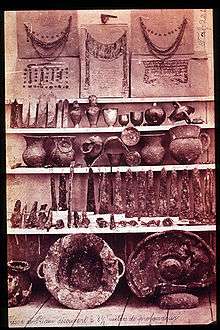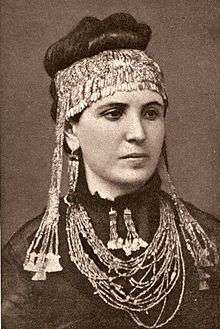Priam's Treasure
Priam's Treasure is a cache of gold and other artifacts discovered by classical archaeologist Heinrich Schliemann at Hissarlik in modern Turkey. The majority of the artifacts are currently in the Pushkin Museum in Moscow.

Schliemann claimed the site to be that of Homeric Troy, and assigned the artifacts to the Homeric king Priam. This assignment is now thought to be a result of Schliemann's zeal to find sites and objects mentioned in the Homeric epics which take place in northwestern Turkey. At the time the stratigraphy at Troy had not been solidified, which was done subsequently by the archaeologist Carl Blegen. The layer in which Priam's Treasure was alleged to have been found was assigned to Troy II, whereas Priam would have been king of Troy VI or VII, occupied hundreds of years later.
Background
With the rise of modern critical history, Troy and the Trojan War were consigned to the realms of legend. In 1871-73 and 1878–79, Schliemann excavated a hill called Hissarlik in the Ottoman Empire, near the town of Chanak (Çanakkale) in north-western Anatolia, Turkey. Here he discovered the ruins of a series of ancient cities, dating from the Bronze Age to the Roman period. Schliemann declared one of these cities—at first Troy I, later Troy II—to be the city of Troy, and this identification was widely accepted at that time.
Concerning events on or about May 27, 1873 Schliemann reported:
In excavating this wall further and directly by the side of the palace of King Priam, I came upon a large copper article of the most remarkable form, which attracted my attention all the more as I thought I saw gold behind it. … In order to withdraw the treasure from the greed of my workmen, and to save it for archaeology, … I immediately had "paidos" (lunch break) called. … While the men were eating and resting, I cut out the Treasure with a large knife…. It would, however, have been impossible for me to have removed the Treasure without the help of my dear wife, who stood by me ready to pack the things which I cut out in her shawl and to carry them away.
Schliemann's oft-repeated story of the treasure being carried by his wife, Sophie, in her shawl was untrue. Schliemann later admitted making it up, saying that at the time of the discovery Sophie was in fact with her family in Athens, following the death of her father.[1]
The treasure

A partial catalogue of the treasure is approximately as follows:
- A copper shield
- a copper cauldron with handles
- an unknown copper artifact, perhaps the hasp of a chest
- a silver vase containing two gold diadems (the "Jewels of Helen"), 8750 gold rings, buttons and other small objects, six gold bracelets, two gold goblets
- a copper vase
- a wrought gold bottle
- two gold cups, one wrought, one cast
- a number of red terra cotta goblets
- an electrum cup (mixture of gold and silver and copper)
- six wrought silver knife blades (which Schliemann put forward as money)
- three silver vases with fused copper parts
- more silver goblets and vases
- thirteen copper lance heads
- fourteen copper axes
- seven copper daggers
- other copper artifacts with the key to a chest
The treasure as an art collection
Apparently, Schliemann smuggled Priam's Treasure out of Anatolia. The officials were informed when his wife, Sophia, wore the jewels for the public. The Ottoman official assigned to watch the excavation, Amin Effendi, received a prison sentence. The Ottoman government revoked Schliemann's permission to dig and sued him for its share of the gold. Schliemann went on to Mycenae. There, however, the Greek Archaeological Society sent an agent to monitor him.
Later Schliemann traded some treasure to the government of the Ottoman Empire in exchange for permission to dig at Troy again. It is located in the Istanbul Archaeology Museum. The rest was acquired in 1881 by the Royal Museums of Berlin (Königliche Museen zu Berlin).[2][3]
After the capture of the Zoo Tower by the Red Army during the Battle in Berlin, Professor Wilhelm Unverzagt turned the treasure over to the Soviet Art Committee, saving it from plunder and division. The artefacts were then flown to Moscow. During the Cold War, the Soviet government denied any knowledge of the fate of Priam's Treasure. However, in 1994 the Pushkin Museum admitted it possessed the Trojan gold.[4][5][6]
Russia keeps what the West terms the looted art as compensation for the destruction of Russian cities and looting of Russian museums by Nazi Germany in World War II. A 1998 Russian law, the Federal Law on Cultural Valuables Displaced to the USSR as a Result of the Second World War and Located on the Territory of the Russian Federation, legalizes the looting in Germany as compensation and prevents Russian authorities from proceeding to restitutions.
Authenticity of the treasure
There have always been doubts about the authenticity of the treasure. Within the last few decades these doubts have found fuller expression in articles and books.[7]
Notes
- Moorehead, Caroline (1994). The Lost Treasures of Troy, Weidenfeld and Nicolson, page 133. ISBN 0-297-81500-8.
- Urice, Stephen K., editor (2007). Law, Ethics and the Visual Arts, Kluwer Law International, page 63. ISBN 90-411-2517-5.
- Greenfield, Jeanette (2007). The Return of Cultural Treasures, Cambridge University Press, page 197. ISBN 0-521-80216-4.
- Tolstikov, 2007.
- Atkinson, Rick (September 6, 1993). "Trojan treasure unlocks art war".
- Akinsha, Konstantin; Kozlov, Grigorii (1995). Beautiful Loot. New York: Random House. pp. 6–11, 20, 41, 60–63, 78, 223, 255. ISBN 9780679443896.
- Wood, 1987; Silberman, 1989; Traill, 1997.
References
- Silberman, Neil Asher (1989). Between Past and Present: Archaeology, Ideology and Nationalism in the Modern Middle East, Doubleday, ISBN 0-385-41610-5.
- Smith, Philip, editor (1976). Heinrich Schliemann: Troy and Its Remains: A Narrative of Researches and Discoveries Made on the Site of Ilium, and in the Trojan Plain, Arno Press, New York, ISBN 0-405-09855-3.
- Tolstikov, Vladimir; Treister, Mikhail (1996). The Gold of Troy. Searching for Homer's Fabled City. Harry N. Abrams. ISBN 0-8109-3394-2. A catalog of artifacts from Schliemann's excavations at Troy, with photographs.
- Traill, David (1997). Schliemann of Troy: Treasure and Deceit, St. Martin's Press, ISBN 0-312-15647-2
- Wood, Michael (1987). In Search of the Trojan War, New American Library, ISBN 0-452-25960-6.
External links
- Art News article, originally published in April 1991 revealing the secret Soviet collections of looted art, including the Schliemann collection.
- Calvert's Heirs Claim Schliemann Treasure
- Scholia reviews at the Wayback Machine (archived May 9, 2008)
- Looted Art BBC radio documentary on art looted by the Soviets at the end of World War II, with special mention of the Schliemann collection
- Pushkin Museum of Fine Arts collection of Schliemann's treasure